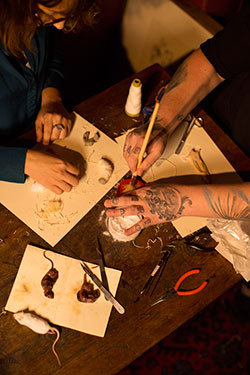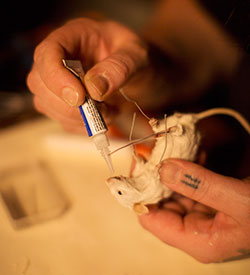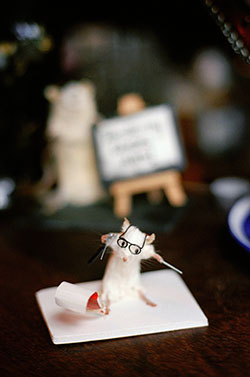FT Masterclass: Taxidermy with Tonja Grung
Simply sign up to the Life & Arts myFT Digest -- delivered directly to your inbox.
We are born, we die, we return to dust. Or, in some cases, we are born, killed, chilled to below zero and snatched from the jaws of a pet snake before being skinned, stuffed and displayed on a bookshelf.
Such was the fate of the little mouse I am spending the day with, learning the art of taxidermy from Tonja Grung. Grung, who grew up on a farm in South Africa, runs Made from the Dead, a taxidermy studio influenced by Victoriana and the macabre. The words “Dead Girl” are tattooed across the back of her knuckles and legible under her latex gloves.
Today’s lesson is taking place at The Last Tuesday Society, a two-storey bar and museum next to the canal in east London. It’s the kind of establishment you could imagine Charles Darwin and John Waters running together as a joint venture, if the two of them were hoarders and they’d taken interior design advice from the high priest of a central American death cult. Shrunken heads, entombed in glass cabinets, keep company with preserved frogs, a dodo skeleton, mutilated dolls and a red-sequined dress-suit. A gold-plated hippopotamus skull hulks in the centre of the room. “This is probably my favourite place in London,” says Grung.
We start work at a table scored with a pentagram, under the gaze of a mummified cat. Grung extracts two mice from her bag and places each on a sheaf of beige paper. “Obviously these have been taken out of the freezer at 6am this morning,” she says, explaining that she bought them as pre-expired reptile food. All her specimens are ethically sourced, in that they aren’t killed for taxidermy. Squirrels can be acquired from food companies that sell to humans; stillborn puppies from breeders.
Grung massages the little mouse bodies, frowning. “I would probably prefer them a bit more frozen,” she says. Fearful, I ask her what the implications are, imagining spurting fluids and a rancid smell. It’s more to do with the risk of cutting through the intestine bag, she explains, which is easier to avoid when the mice are harder. We lay the creatures on their backs and Grung shows me how to part the fur down the middle of the belly with the back of a scalpel, so we have some hair to cover our stitches.
I mentally recoil at the idea of the incision but the anticipation is worse than the act itself. Gently, as though drawing in fine pencil, Grung shows me how to slice down from the chest to the top of the legs, easing the pressure as the skin thins over the abdomen. “You don’t want the cut too far down, because when you try to turn it inside out, you’ll just tear it to the tail,” she explains.
Next, we use tweezers to lift up the edges of the cut and slide the backs of our scalpels inside, to separate the membrane enclosing the organs from its casing of skin. It’s slow work and I’m being too tentative, as if inflicting pain on a living creature. “You think they’re delicate but they’re actually not – they’re quite robust,” Grung says.

Eventually, I work my way to the spine and spring loose the limbs. Grung shows me how to push my forefinger through the layer between the skin and the body sack at the back — “like a ring going on a finger” — so the carcass hangs free. We do the same under the knees and snip off the legs at the ankle with a pair of scissors. They make an unpleasant crunching noise.
It takes 25 minutes of intense concentration to flip over the skin and remove the tail from its bone. Doing so demands delicacy and force, as if engaged in a miniature rope-pulling exercise. If you cut through the tendons, the vertebrae will collapse and you won’t be able to get the tail off, Grung explains.
Strangely, I don’t feel like I’m violating the animal any more; instead, seeing it in this vulnerable state, my impression is one of tenderness for our shared incarnate existence. I find myself contemplating the brief arc of its life, what it had been like to snuffle around with its siblings.
These emotions of titillation, revulsion and wonder are bound up with the history of taxidermy itself. The term comes from the Greek taxis, to arrange, and derma, skin. It dates back to the “cabinets of curiosity” popular with genteel European collectors in the age of discovery, but the practice really took off during the great industrialising and classifying spree of the 19th century, when a morbid spiritualism also held sway among the bourgeoisie. In her book The Breathless Zoo, Rachel Poliquin argues that taxidermy springs from contradictory longings: a will to possess, classify and dominate nature, but also a desire to venerate, protect, and recognise our affinity with it.
More recently, taxidermy has occupied a special place in the firmament of kitsch. But judging by the inflation in the deer-head-to-floorspace ratio in London and New York bars, and the profusion of do-it-yourself classes, taxidermy has been enjoying a revival. Perhaps that’s not surprising — irony and animals are the cultural currency of the internet era, especially when they go together in meme-ified form.

Next comes the head. Keeping the skin flipped taut over the forehead, we scrape away the glands and nick through the ear canal and membrane over the eye. Grung suspends the body from the skin, adjusts the scissors at a 45-degree downward angle against the cheek, and cuts. I’m left with just the nose and two front teeth.
“I find them really beautiful at this stage,” Grung says. Without skin, the bodies do have a certain grace, the chest area filigreed with ribs, over a dark carmine that lightens towards the stomach. They’ve stained the paper we’ve been working on, like Yves Klein models rolling on a canvas. By now there’s a distinctive smell, sour and peppery, but not too unpleasant. The only bit of blood is on the tip of their noses.
We spend the next half hour scraping away the residue fat and membrane with the bottom of the scalpel and then apply three successive solutions of alcohol, detergent and moth repellent. We turn the skins the right way round and pinch the face to pop out the noses. Grung still takes a childish delight in their appearance: “Look how angelically they float!”

At one point, Viktor Wynd, the collector, artist and owner of the Last Tuesday Society, descends the stairs in a green gabardine jacket. “I thought I’d give you some reading,” he says, dropping three books of baroque erotica on the table, including “Men in Lace: TV Hostage (a cross-dressing novel for adults only)”. He and Grung chat affably about the prospect of an “obscene taxidermy” class to coincide with Valentine’s day, before he sweeps out again.
As the mice soak, we build their bodies from strings of wood shavings wound around with thread, modelled on the shape of our carcasses, with dabs of clay to give roundness to the face. I use a hairdryer to blow-dry the hair until the fur is babyfluff-soft, turn it inside out, and dab it with tanning solution and borax, a white drying powder.
By now we’re in the final stages, having threaded pieces of wire through the body for the hands and feet with points coming out at each paw. Grung shows me how to fatten the inside of the limbs with bits of clay.
After four hours of concentration, I’m now flagging. Grung threads my needle and we sew up the stomachs using a baseball stitch which conceals the thread within the seam. I can’t suppress a squeal of delight at my creation — especially when Grung brings out a tiny notepad and pair of glasses. And there it is: my mouse is transformed into a miniature reporter.
Slideshow photographs: Sophie Green
Comments